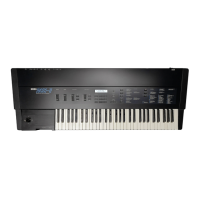■ The normal procedure for making a system for perfor
mance on the DSS-1 is as follows.
1. In the system mode, assemble the muitisounds
that you will need.
2. In the system mode, assemble the programs
that you will need.
3. In the program parameter mode, assign multi
sounds to OSC-1 and OSC-2. If necessary, also
adjust values for VCF, VGA, delay, and other
parameters.
4. In the program parameter mode, write changed
values from program output buffer to program
memory.
5. Repeat steps 3 and 4 to make your 32 pro
grams.
6. In the system mode, save the system to disk.
This completes one system and preserves it on disk.
To perform with this system again, use the Ft G ET
SY ST EM function to load it from disk to memory.
System structure
Program memory.
| Note:
; You can't make a complete system by only collec-
I ting programs and multisounds. You must use the
■ program parameter mode to assign multisounds to
= the oscillators and then write the changes to pro-
; gram memory.
71 Disk Utility Mode
■ Functions in the disk utility mode.
This mode lets you perform the following tasks with
your disks.
• Format newly purchased disks to ready them for
use in the D SS-1.
• Protect saved data from accidental erasure or
change,
• Display a directory of saved multisound, sound,
and program names.
• Delete unwanted multisounds and sounds from
disks.
• Display used and free (available) number of blocks
on a disk.
Initial display for disk utility mode
***_DI5K UTILITY ***
s p l e c i - 0 3 " “7 ’ ) »
: Note:
i If you delete a multisound that is used by a system
! on a disk, then you will get an “Incompleted"
j message if you try to get (load) that system from
! disk to memory.
59
GENERAL OPERATION

